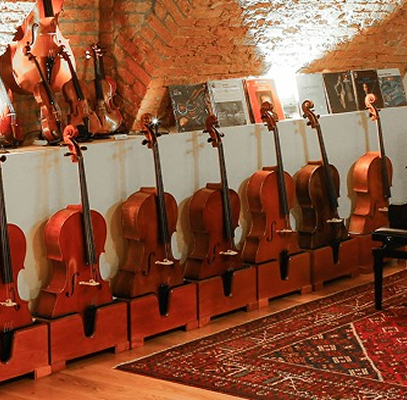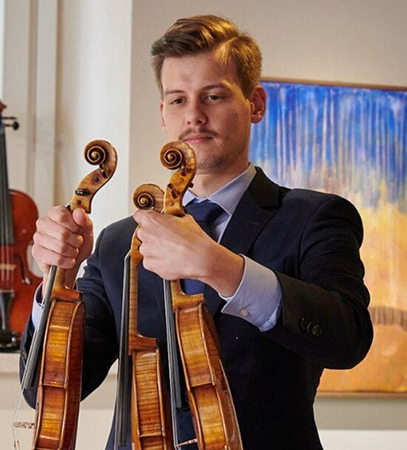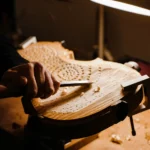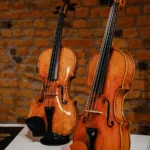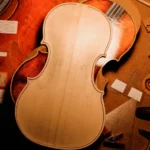Violin Bow Practical Tips: Care, Repair & Maintainance
Back to BlogViolin Bow Practical Tips: Care, Repair & Maintainance
Your violin bow is more than just a tool; it’s a statement piece that produces not only sounds but emotions. Just like any other instrument, violin bows also demand care and maintenance to perform the best. This blog is the ultimate guide to understanding the violin bow, its daily care and maintenance and violin bow tips for the rehairing process. So, let’s get into it.
Components of A Violin Bow:
To take the best care of your violin bow, it’s crucial to deeply understand its components first. Before exploring the best tips to take care of a violin bow, first dig into the intricacies of a violin bow. The key components of a violin bow are:
- Stick: The bow stick serves as the backbone of the violin bow. It’s a long, curved wooden structure that impacts the bow’s response and feel and how the bow grips the strings.
- Frog: The bottom part of the bow is called a frog, usually made of dark and dense wood. It is concerned with hair tension as it holds the screwings that control it.
- Screw: It is a metal component that affects the sound production and responsiveness of the bow by tightening and loosening the bow hair.
- Hair: Violin bow hair is the key part as it produces sound upon coming in contact with the strings. They are usually made of horsehair, and the type of hair, condition, and tension affect the tone of the bow.
The Violin Bow Practical Tips On Care Repair And Maintenance
Cleaning the Bow
It’s crucial to clean your bow after every performance to maintain its appearance and keep it functional. A dry flannel, which is a dry and soft cloth is recommended to use for cleaning purposes. Wipe down the stick with it to remove rosin buildup or dust particles. A soft toothbrush can also be used gently to remove loose particles.
Storing the Bow
Storing the bow in the correct manner extends the lifespan of the violin bow. A cool, dry place that is away from direct sunlight and heat sources is the ideal condition for storing it. Furthermore, always use a high-quality, cleaned and dried bow case to store your bow, as it will protect it from all exterior impacts. When storing, it’s advised to loosen the bow hair to relieve the tension.
Caring the Bow Hair
The tone and pitches of the sound are directly affected by the health of the violin bow hair. Taking care of the humidity is necessary if you want the bow hair to stay in good condition. The higher humidity levels result in unresponsiveness of the bow hair and might make the hair limp. Whereas, the lower humidity levels may cause brittleness.
To avoid such issues, use a humidifier to encounter lower humidity levels and a dehumidifier to address the high humidity concern. Additionally, don’t tighten the bow hair a lot as overtightening can damage the hair and reduce the lifespan of the bow. Avoid unnecessary bending or twisting of the bow hair to keep its shape intact.
Applying the Rosin
Rosining your bow hair enhances the friction between the bow hair and strings. However, applying rosin in the correct quantity is important to achieve the desired sound and grip. Too much rosin can create a harsh sound, whereas a small quantity of rosin may cause the bow to slip. After selecting the right quantity of rosin, apply the rosin dust evenly throughout the hair length. Always opt for high-quality rosin to minimize the rosin buildup.
Recognizing Signs of Damage
As the care and maintenance of a violin bow is crucial, it’s also necessary to understand the signs of damage so that you can address them instantly. Here are the four signs to watch out for if you want to keep your bow in top condition.
Loose Hair:
Loose bow hair is one of the most common issues that violinists face. The decline in bow sound, decreased responsiveness, or reduced grip effectivity are the major signs of hair loosening. In addition to this, if you observe the hair slipping out of the frog, it’s also an indicator of loose hair that needs to be fixed for clear and consistent tones.
Cracked Stick:
The stick of the violin bow is made up of Pernambuco wood for rich and warm tones. However, it is highly susceptible to cracking due to extreme temperatures, humidity, or accidental impacts. It’s noticeable that sometimes violinists don’t even get to know about the crack as it’s not visible and only detectable by an expert. The unfortunate part is that sometimes the cracked stick can’t be adequately fixed to maintain the same bow properties.
Worn Frog:
The frog is the crucial part that serves as the housing for screwing and holds the hair as well. It impacts the bow balance, grip, and hair tension, so its wear and tear needs immediate action.
Loose parts, cracks, or chips in the ebony wood are the signs of a worn frog; however, the thumb leather that provides grip to violinists may also become worn or damaged. A worn frog affects the whole feel of the bow and playability, making it uncomfortable or difficult to control.
Screw Problems:
Screws are responsible for adjusting the tension of the bow hair. If the screw system is not up to the mark, it can significantly impact the bow’s performance. With damaged or malfunctioning screws, violinists have to encounter issues in turning the screws or slipping off the hair and face difficulty in achieving the desired bow weight and balance.
The Rehairing Process
Rehairing the violin bow involves replacing the worn-out horseshow hair with the new one to maintain the quality and performance of the sound. Continue reading to find out when rehairing is required, how to choose the right hair for rehairing, and what the rehairing process is.
When to Rehair A Bow?
Here are the few indicators that mean that rehairing of the bow is required:
- The first and most obvious sign is the deteriorating quality of the sound. So, when you notice that the produced sound is dull and lacking brilliance and clarity, it’s high time to get your bow rehaired.
- If you observe the hair strands slightly coming out of the frog, it’s a sign that rehairing is necessary.
- If the hair requires a large quantity of rosin for grip, it’s another indication of worn hair that needs to be replaced.
Choosing the Right Hair
Here are the factors that influence the choice of the right hair.
- Preference of the Player: Every player has their own style and preferences. Some prefer a brighter or focused sound, whereas some are into warmer and richer tones. This set of preferences is another factor that influences the choice of hair.
- Hair Quality: The quality of the hair affects the overall performance of the bow. The better the quality, the more flexible, durable, and responsive the bow will be.
- Climate: Climatic conditions such as humidity and temperature affect the quality and life of the hair. So, choose the ones that go well with your environment.
How to Rehair the Bow? A Step-by-Step Guide:
The process of rehairing comprises the following steps, and one must seek professional assistance as the professionals know how to repair the violin bow properly.
- The foremost step is to select the bow depending on the bow’s specifications and the violinist’s preference.
- The old hair is then removed from the frog and cleaned later to prepare it for the new hair.
- Ensuring that the hair strands are evenly distributed and securely held in place, the prepared hair is inserted in the frog.
- The hair is tightened until it achieves the desired tension.
- The final step is the trimming and shaping of the hair to achieve the desired length and camber.
Now you can rely on Amorim’s new service, rehair of your bow. With years of experience in the care and maintenance of fine instruments and bows, our team of luthiers is dedicated to providing the highest quality workmanship. We take pride in delivering results that meet the needs of both amateur and professional musicians.
All in all, proper care of your violin bow is required to enhance its life span and the quality of the music produced by the violin. If you follow the above-mentioned violin bow tips for rehairing and maintenance, you can keep using your violin bow for years. To find the best quality string intruments, and their bows visit Amorim Fine Violins, which specializes in curating the finest quality instruments.

